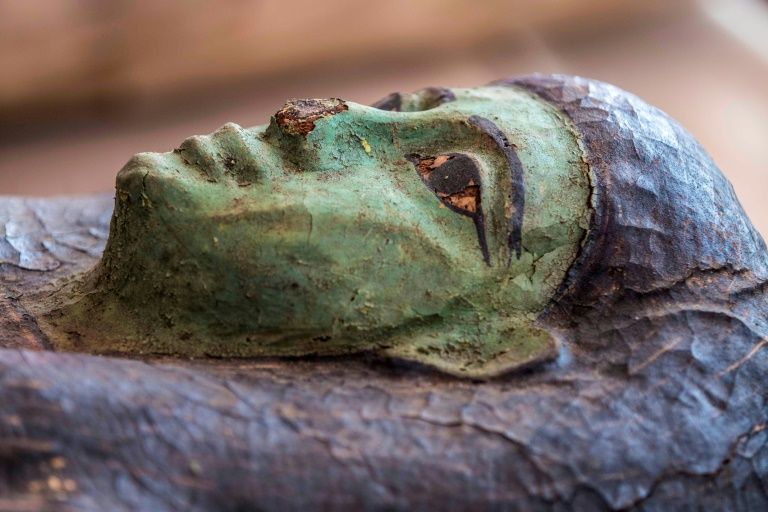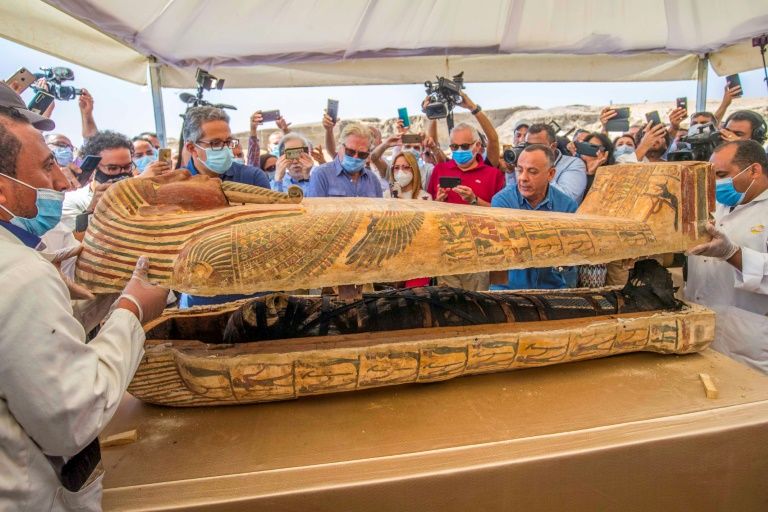Archaeologists in Egypt said Saturday they had found 59 well-preserved and sealed wooden coffins over recent weeks that were buried more than 2,500 years ago.
Opening one of the ornately decorated sarcophagi before assembled media, the team revealed mummified remains wrapped in burial cloth that bore hieroglyphic inscriptions in bright colours.
The dramatic find was unearthed south of Cairo in the sprawling burial ground of Saqqara, the necropolis of the ancient Egyptian capital of Memphis, a UNESCO World Heritage site.
"We are very happy about this discovery," said Mostafa Waziri, secretary general of the Supreme Council of Antiquities.
Since the find of the first 13 coffins was announced almost three weeks ago, more have been discovered in shafts at depths of up to 12 metres (40 feet).
An unknown number of additional coffins may still lie buried there, the tourism and antiquities minister, Khaled al-Anani, said at the site, near the 4,700-year-old pyramid of Djoser.
"So today is not the end of the discovery, I consider it the beginning of the big discovery," he said.
The coffins, sealed more than 2,500 years ago, date back to the Late Period of ancient Egypt, from about the sixth or seventh century BC, the minister added.
Excavations in Saqqara have in recent years unearthed troves of artefacts as well as mummified snakes, birds, scarab beetles and other animals.
|
|
| Egypt's tourism and antiquities minister, Khaled al-Anani (L), and Mostafa Waziri (R), secretary general of the Supreme Council of Antiquities, open a sarcophagus excavated at the Saqqara necropolis. Photo: AFP |
Major discovery
The discovery of the coffins is the first major announcement since the outbreak of Covid-19 in Egypt, which led to the closure of museums and archaeological sites for around three months from late March.
Dozens of statues were also found in the area including a bronze figurine depicting Nefertem, an ancient god of the lotus blossom.
Preliminary studies indicated the sarcophagi likely belonged to priests, senior statesman, and prominent figures in the ancient Egyptian society of the 26th dynasty, Anani said.
All the coffins would be taken to the soon-to-be-opened Grand Egyptian Museum on the Giza plateau, he added.
They would be placed opposite a hall hosting 32 other sealed sarcophagi for priests from the 22nd dynasty, which were found last year in the southern city of Luxor.
The opening of the Grand Egyptian Museum, which has been delayed several times, is planned for 2021.
The museum will host thousands of artefacts, spanning multiple eras of Egypt's history, from the pre-dynastic to the Greco-Roman period.
Egypt hopes a flurry of archaeological finds in recent years and the Grand Egyptian Museum will boost its vital tourism sector, which has suffered multiple shocks since the 2011 Arab Spring uprisings, most recently the pandemic.





















































